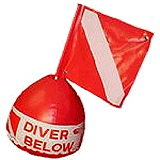Open ocean diving
The extreme case of open water is the deep open ocean, where the bottom is at a depth which is irrelevant to the diver as there would be no chance of surviving long enough to reach it. Open oceanic water is often remarkably clear, but this is not always the case. There is no natural visual reference for depth in the open ocean, and depth monitoring is critically important to diver safety.
Blue-water diving


Blue-water diving is done in mid-water where the bottom is out of sight of the diver and there may be no fixed visual reference. It is used by scientific divers for direct observation and sampling of pelagic organisms and particulate matter, particularly the gelatinous zoo-plankton that are fragile and transparent, making them relatively inaccessible by other methods, [6] and by recreational divers for observation and photography of a range of organisms not easily seen in inshore waters.
The techniques of blue-water diving have been developed over the years to suit the conditions and address the hazards of an environment which is functionally bottomless, and has no fixed visible positional references. The diver who is focused on small organisms or instruments at close range is likely to have diminished awareness of depth, buoyancy, current, surge, other divers, large organisms, and even the direction to the surface. [6]
An accepted procedure for scientific blue-water collection diving with several working divers, is to tether the working divers to a central hub connected to a surface platform, and to have an in-water safety diver attend the hub. The tethers pass through fairleads at the hub and are tensioned by a weight at the end, which keeps slack out of the line and thereby reduces the risk of entanglement, and prevents the end of the line from passing through the fairlead. The tether serves to limit the distance a diver can move away from the hub, which is typically fastened to a substantial downline supported by a large buoy at the surface, and kept vertical by a weight. The float at the surface allows the divers to move freely in the water column within the constraint of the tether, and drift with the current. The tethers also allow rope signals between the safety diver and the working divers. The surface platform, generally a small boat, may be tethered to the buoy, and if there is sufficient wind to make this a problem a parachute sea anchor can be deployed to minimise drift. Windage will generally position the buoy and boat downwind of the parachute. The other end of the tether is clipped to the diver's harness or buoyancy compensator by some form of quick-release shackle. [6] These procedures and equipment can also be used at night.
If a sea anchor is deployed to limit drift, it must be kept clear of the divers to minimise the risk of entanglement, and it should be buoyed to prevent sinking in a calm. The sea anchor cable should be buoyant line for the same reason. Blue-water diving operations are constrained by water and weather conditions, including wind, sea state, current strength, visibility, and the presence of aggressive predators. [6]
Black-water diving and blackwater photography
Black-water diving is mid-water diving at night, particularly on a moonless night. The environment is referred to as black-water . [7] [8] The term black-water may also be used to refer to diving in zero visibility, or in sewage. Christopher Newbert, author of Within a Rainbow Sea, (1984) is credited as an early black-water diver. [9] In his book, he describes solo offshore night dives to depths of up to 150 feet (46 m). [10] Black-water diving is often done as a photographic opportunity for recreational divers as there can be a wide range of plankton that would not often be seen by day or closer inshore. [11] This is known as blackwater photography. [12]
Weighted downlines are commonly used to provide a stable vertical reference. These may be tied to the boat or supported by a buoy. Each diver may be attached to a downline using a shorter tether to ensure that divers do not go too far from the boat or too deep. [11] The downline may be marked with lights to indicate depth and to attract mobile organisms. [10] A wide range of animal life may be seen, including many species that spend the daylight hours at depths below those accessible to ambient pressure divers, and migrate vertically through the water column on a diurnal cycle. [9] Many of these are bioluminescent or translucent or both. [10]
The boat moves differently from the divers and the divers move differently from the plankton, making it necessary to work to get a position from which there will be enough time to frame and take photos of the drifting subjects. The boat will drift under the influence of current and wind, while the divers and plankton will drift with the current. If there is wind the boat will drag the downlines, and if tethered to the buoy, it will drag the buoy and divers attached. If divers swim ahead of the towing action, they will have a short time to drift with the plankton and take photos until the slack in the line has been taken up, at which point the plankton will be left behind. [11] This drift problem can be reduced by setting a parachute anchor, which will reduce wind drift to a negligible amount. The divers should stay clear of the entanglement hazard of the parachute suspension lines. [7]











